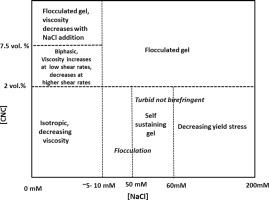Current Opinion in Colloid & Interface Science ( IF 7.9 ) Pub Date : 2017-02-12 , DOI: 10.1016/j.cocis.2017.02.002 Hale Oguzlu , Christophe Danumah , Yaman Boluk

|
In this short review, we discuss the colloidal microstructure of sulfonated cellulose nanocrystal (CNC) suspensions and connect to their rheological behavior in the presence of electrolyte, by changing its surface chemistry and also in dilute water soluble polymer solutions. Presence of electrolyte has a significant effect depending both on the concentrations of CNC and electrolyte. The salt presence on the microstructure of CNC suspensions were successfully explained by DLVO theory. Even within the dilute concentration regime (< 0.5 vol%), CNC particles can form gels either by adding high concentration of electrolyte or low concentration (around overlapping concentration) of non-adsorbing polymer. Addition of water soluble polymers may cause depletion of CNC if the polymer is not adsorbing. It is believed that the depletion flocculation is the case for the effects of carboxymethyl cellulose (CMC) polymer chains in CNC suspensions and cause significant gelling.
中文翻译:

水性纤维素纳米晶体悬浮液的胶体行为
在这篇简短的评论中,我们讨论了磺化纤维素纳米晶体(CNC)悬浮液的胶体微观结构,并通过改变电解质的表面化学性质以及在稀的水溶性聚合物溶液中,在存在电解质的情况下连接到其流变行为。电解质的存在对CNC和电解质的浓度都有很大的影响。用DLVO理论成功地解释了CNC悬浮液微观结构中的盐的存在。即使在稀释浓度范围内(< 0.5 通过添加高浓度的电解质或低浓度(大约重叠浓度)的非吸附性聚合物,CNC颗粒可以形成凝胶。如果聚合物不吸附,则添加水溶性聚合物可能会导致CNC的消耗。据信,对于CNC悬浮液中羧甲基纤维素(CMC)聚合物链的作用而言,消耗絮凝是一种情况,并导致明显的胶凝。











































 京公网安备 11010802027423号
京公网安备 11010802027423号